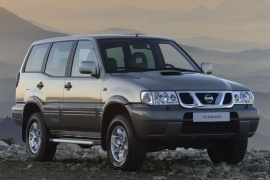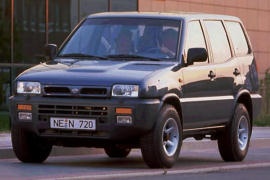
NISSAN Terrano 5 Doors
Generations Timeline, Specs and Pictures

The Terrano name was successful in the European and other markets around the world, but it was axed once the Japanese carmaker went into an alliance with Renault.
But, in 2013, they brought it back.
Being into an alliance with Renault brought some advantages to Nissan. Even though the Japanese carmaker was an expert in the 4x4 sector, it didn’t succeed to make affordable, unibody, SUVs. In Europe, the best SUV recipe was the Dacia Duster, which was sold on some other markets as the Renault Duster. Nissan engineers took that compact SUV and reshaped it in the form of the 2013 Terrano.
Nissan started to work on the car by changing the front fascia to a more recognizable grille from a Nissan Patrol with chromed slats and bigger, angular headlights. On the side, a subtle line was drawn on the bottom of the doors. The liftgate featured an additional light unit on it, to complement the fixed to the body taillights.
Inside the car, there was the same adequate room for a compact SUV vehicle. Five adults could fit inside the car. The multimedia unit was different than the one found on the Renault/Dacia Duster.
Under the hood, the Terrano featured the same engines as the Duster, with front or all-wheel-drive systems. The all-wheel-drive versions featured independent suspensions on all four corners, while the front-wheel drive version was fitted with a twisting beam in the back.

The second generation of the European Nissan Terrano was introduced to the market in 1996 and it was a joint development program with Ford.
While the Ford Maverick was withdrawn, the Terrano II continued its journey on the market until 2006.
For the European version, the Nissan Terrano II received a body-on-frame platform, with a front independent suspension and a rear axle. It was not the hard-core off-road specialist as its bigger brother Patrol, but it was praised for its comfortable ride on pavement. Its handling was not its biggest advantage.
From the outside, the ascending roofline was needed to offer more headroom for the rear passengers, but it was the same idea introduced by Land Rover Discovery. The Terrano II featured an ascending beltline. In 2002 it went through a final facelift that brought better engines and a steering wheel carry-over from the Nissan Primera.
Inside, the Terrano II was available with up to seven seats, the last row being installed in the trunk area. The folding bench was wide enough to fit two slim adult passengers, but with limited hip and legroom. The dashboard featured a car-like layout, with a center stack and a high-mounted audio system.
Under the hood, there was the same 2.7-liter diesel engine, but a new, 3.0-liter unit was introduced. It was the same used for its bigger brother, the Nissan Patrol. All versions were part-time 4x4 with a low-range gear and the standard transmission was a 5-speed manual. Depending on the market, an option for 4-speed automatic was on the options list.

The year 2000 saw the introduction of a refreshed vehicle with better looks and more brawn than the previous generation.
While visuals were well improved, so were the engines. The 2.7 L Turbocharged unit gained an intercooler that led to a 25% power output increase over the older engine. Despite the generous seating layout that could accommodate up to 8 passengers, comfort is said to be an issue. With few parts likely to fail, the 4X4 Terrano is widely regarded as a vehicle equipped with some of the best ABS systems out there. Low maintenance costs and good fuel consumption have also contributed to the car’s popularity.

Nissan introduced a mid-life cycle refresh for its European SUV Terrano II built in Spain along with the Ford Maverick.
The Japanese carmaker managed to grow in the hearts of the European and British car buyers that were looking for a family-oriented SUV. Its comfortable front independent suspension and roomy interior, combined with fuel-efficient engines, were well received by the market. After just three years since it was introduced, it received a mid-life cycle refresh meant to improve the engines and made them Euro 2 compliant. The new emission rule was mandatory from January 1997.
From the outside, the main difference was at the front, where the car adopted four round headlights instead of the rectangular ones used on the previous model. Also, the grille got wider gaps to allow better cooling needed, especially in rough terrain. Depending on the trim level, the Terrano II featured plastic side moldings to protect the doors and panels from scratches and bush-markings. Even though its longer wheelbase and cabin allowed the carmaker to move the spare-wheel inside the trunk, Nissan chose to leave it attached to the rear on a separate cradle.
Some visual changes were on the interior, where Nissan mounted a new dashboard and instrument cluster. The carmaker introduced an LCD for the odometer on top of the instrument panel. An important addition was the airbag introduction for both front occupants. Nissan even tried to offer more comfort and luxury-inspired features such as the wood-trims on the center stack and door panels.
Under the hood, Nissan installed a 2.7-liter turbo-diesel engine, which gained 24 hp over its predecessor. It was the main engine choose by the European customers. On the other hand, the 2.4-liter gasoline unit lost six horsepower due to a catalytic converter.

Nissan and Ford decided to build an SUV especially for the European customers in a Spanish factory, and the result was the Terrano II/ Maverick lineups.
In 1993, Nissan unveiled the SUV continuing the Terrano name. It was received with great expectations since the carmaker was already known for its offroad vehicles. That helped Nissan sells more cars than Ford of Europe. It also used different trims and upholstery inside the Terrano II cabin.
Nissan’s designers chose to install rectangular headlights on the Terrano II and a slim grille between them, which sported the company’s badge on its upper side. On the sides, depending on the options, a set of side steps were available. Strangely though, the carmaker didn’t offer side moldings to protect the bodywork from bushes and minor scratches. Its ascending beltline looked softer than on the three-door version since it started on the rear doors. Even though its longer wheelbase and cabin allowed the carmaker to move the spare wheel inside the trunk, Nissan chose to leave it attached to the rear on a separate cradle.
Nissan offered the Terrano II with a five or seven-seat option, with jump-seats in the trunk. Thanks to the folding second and third row of seats, the car could get up to 1,900 liters (67 cu-ft) of cargo behind the front seats. Depending on the trim level, the carmaker fitted either a cloth upholstery or a leather-clad interior.
The vehicle was built on a chassis, with a front independent suspension and a five-link rear axle. It was powered either by a 2.4-liter gasoline engine or a 2.7-liter turbodiesel. All versions were part-time 4x4 with a low-range gear, and the standard transmission was a 5-speed manual. Depending on the market, an option for a 4-speed automatic was on the options list.

Built on Nissan’s WD21 platform, shared with the Pathfinder, the 5-door version of the popular Terrano had little details that set him apart from its agile 3-door counterpart.
Besides having an obvious extra set of doors, the car was heavier and had larger front and rear track. Other than that, the overall size of the car was identical to that of the 3-door variant. As with the latter, the vehicle came equipped with the traditional range of engines with capacities of 3.0 L for the petrol unit and 2.7 L for the Diesel plant. The 2.4 L petrol plant was never introduced on the long variant.























































